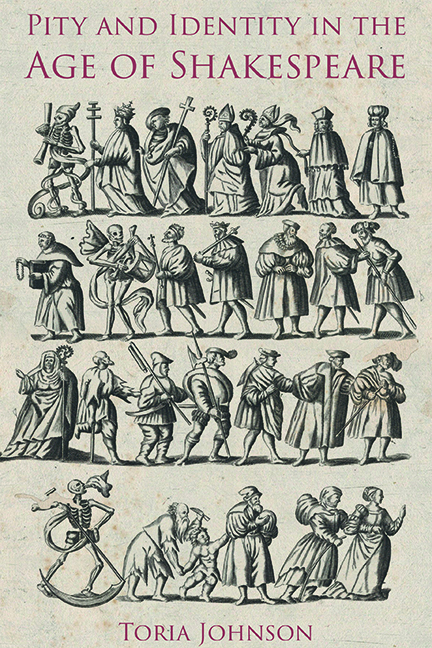Book contents
- Frontmatter
- Dedication
- Contents
- Acknowledgements
- Textual Note
- Introduction
- 1 ‘My name is Pity’: Mediated Emotion and King Lear
- 2 Violent Spectacle and Violent Feeling in Early Modern Lucrece Narratives
- 3 Dramatic Reworkings of Poetic Pity
- 4 Theorising Humanity Through Pity
- Conclusion
- Bibliography
- Index
- Miscellaneous Endmatter
2 - Violent Spectacle and Violent Feeling in Early Modern Lucrece Narratives
Published online by Cambridge University Press: 07 October 2022
- Frontmatter
- Dedication
- Contents
- Acknowledgements
- Textual Note
- Introduction
- 1 ‘My name is Pity’: Mediated Emotion and King Lear
- 2 Violent Spectacle and Violent Feeling in Early Modern Lucrece Narratives
- 3 Dramatic Reworkings of Poetic Pity
- 4 Theorising Humanity Through Pity
- Conclusion
- Bibliography
- Index
- Miscellaneous Endmatter
Summary
THE P[RINTER]. TO THE READER.
When publisher John Day released the second edition of Thomas Norton and Thomas Sackville's Gorboduc in 1570, he was releasing the material to a reading public that had already had printed access to the play for a full five years. In an oft-cited note preceding the text, Day conjures an anthropo-morphic history of the ‘exceedingly corrupted’ first printing as his justification for the second edition:
One W.G. getting a copie thereof at some yongmans hand that lacked a little money and much discretion, in the last great plage, an[no]. 1565, about five yeares past, while the said Lord was out of England, and T. Norton farre out of London, and neither of them both made privie, put it forth excedingly corrupted: even as if by meanes of a broker for hire, he should have entised into his house a faire maide and done her villainie, and after all to bescratched her face, torne her apparell, berayed and disfigured her, and then thrust her out of dores dishonested.
While the piece begins with a standard account of a corrupted copy accessed without the knowledge and permission of its authors, Day quickly escalates the emotional impact by recasting the first edition as an assaulted woman. Lured in by a waiting tormentor, ‘she’ is physically attacked, then pushed back out into the public bearing the signs of her torment. This shift places the earlier printing activity in the register of personal, moral, and physical violation, but in its editorial context, the stakes as Day lays them out are disproportionately dramatic. In truth, Day seems to have made relatively few content changes to the 1565 edition, a consideration which gives a distinct sense of the note – and its emotional strategies – as ‘mischievous commercial special pleading’. The distance Day seeks from the ‘disfigured’ and feminised 1565 text collapses further as his story continues, and he becomes entangled in increasingly problematic language:
In such plight after long wandring she came at length home to the sight of her frendes, who scant knew her but by a few tokens and markes remayning.
- Type
- Chapter
- Information
- Pity and Identity in the Age of Shakespeare , pp. 75 - 116Publisher: Boydell & BrewerPrint publication year: 2021



